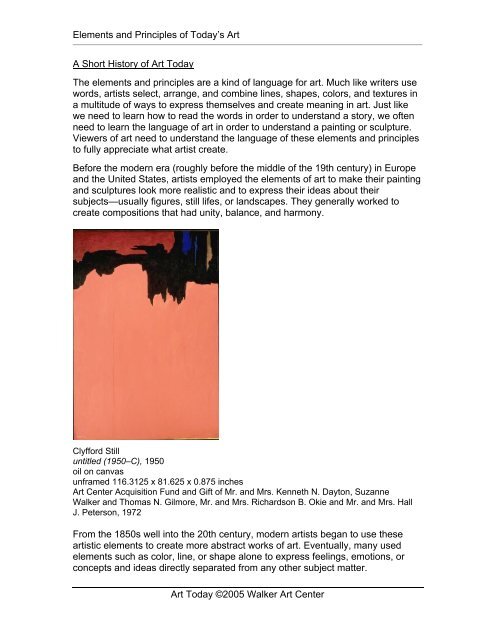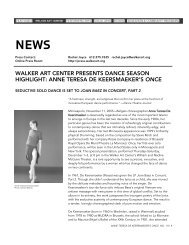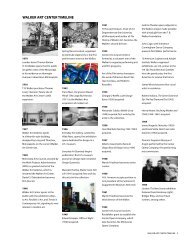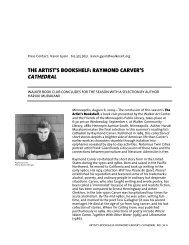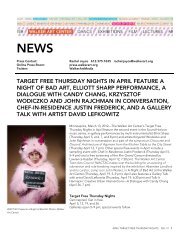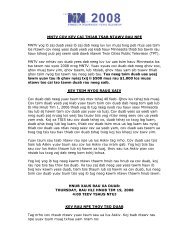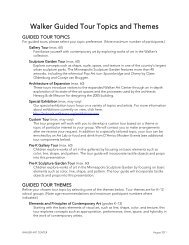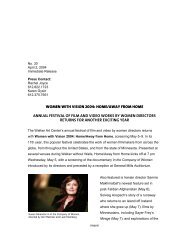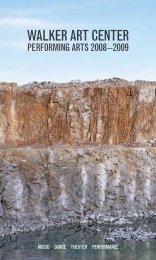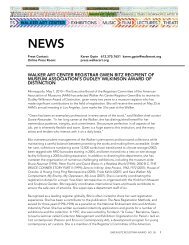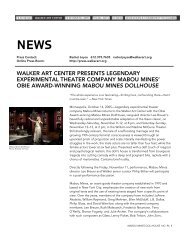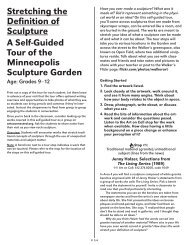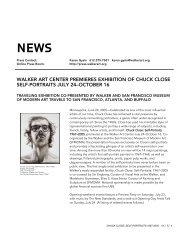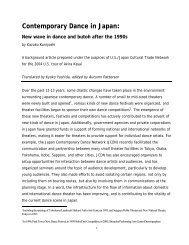Elements and Principles of Today's Art Art Today ... - Walker Art Center
Elements and Principles of Today's Art Art Today ... - Walker Art Center
Elements and Principles of Today's Art Art Today ... - Walker Art Center
You also want an ePaper? Increase the reach of your titles
YUMPU automatically turns print PDFs into web optimized ePapers that Google loves.
<strong>Elements</strong> <strong>and</strong> <strong>Principles</strong> <strong>of</strong> <strong>Today</strong>’s <strong>Art</strong><br />
A Short History <strong>of</strong> <strong>Art</strong> <strong>Today</strong><br />
The elements <strong>and</strong> principles are a kind <strong>of</strong> language for art. Much like writers use<br />
words, artists select, arrange, <strong>and</strong> combine lines, shapes, colors, <strong>and</strong> textures in<br />
a multitude <strong>of</strong> ways to express themselves <strong>and</strong> create meaning in art. Just like<br />
we need to learn how to read the words in order to underst<strong>and</strong> a story, we <strong>of</strong>ten<br />
need to learn the language <strong>of</strong> art in order to underst<strong>and</strong> a painting or sculpture.<br />
Viewers <strong>of</strong> art need to underst<strong>and</strong> the language <strong>of</strong> these elements <strong>and</strong> principles<br />
to fully appreciate what artist create.<br />
Before the modern era (roughly before the middle <strong>of</strong> the 19th century) in Europe<br />
<strong>and</strong> the United States, artists employed the elements <strong>of</strong> art to make their painting<br />
<strong>and</strong> sculptures look more realistic <strong>and</strong> to express their ideas about their<br />
subjects—usually figures, still lifes, or l<strong>and</strong>scapes. They generally worked to<br />
create compositions that had unity, balance, <strong>and</strong> harmony.<br />
Clyfford Still<br />
untitled (1950–C), 1950<br />
oil on canvas<br />
unframed 116.3125 x 81.625 x 0.875 inches<br />
<strong>Art</strong> <strong>Center</strong> Acquisition Fund <strong>and</strong> Gift <strong>of</strong> Mr. <strong>and</strong> Mrs. Kenneth N. Dayton, Suzanne<br />
<strong>Walker</strong> <strong>and</strong> Thomas N. Gilmore, Mr. <strong>and</strong> Mrs. Richardson B. Okie <strong>and</strong> Mr. <strong>and</strong> Mrs. Hall<br />
J. Peterson, 1972<br />
From the 1850s well into the 20th century, modern artists began to use these<br />
artistic elements to create more abstract works <strong>of</strong> art. Eventually, many used<br />
elements such as color, line, or shape alone to express feelings, emotions, or<br />
concepts <strong>and</strong> ideas directly separated from any other subject matter.<br />
<strong>Art</strong> <strong>Today</strong> ©2005 <strong>Walker</strong> <strong>Art</strong> <strong>Center</strong>
<strong>Elements</strong> <strong>and</strong> <strong>Principles</strong> <strong>of</strong> <strong>Today</strong>’s <strong>Art</strong><br />
Sigmar Polke<br />
Frau Herbst und ihre zwei Töchter (Mrs. Autumn <strong>and</strong> Her Two Daughters), 1991<br />
artificial resin, acrylic on synthetic fabric<br />
unframed 118 x 196.75 x 1.625 inches<br />
Gift <strong>of</strong> Ann <strong>and</strong> Barrie Birks, Joan <strong>and</strong> Gary Capen, Judy <strong>and</strong> Kenneth Dayton, Joanne<br />
<strong>and</strong> Philip Von Blon, Penny <strong>and</strong> Mike Winton, with additional funds from the T.B. <strong>Walker</strong><br />
Acquisition Fund, 1991<br />
At the end <strong>of</strong> the 20th <strong>and</strong> beginning <strong>of</strong> the 21st centuries, art historians <strong>and</strong><br />
critics noticed a difference in ways that artists worked <strong>and</strong> the ideas that<br />
interested them. They began to describe this era as postmodern, literally “after<br />
modern.” Postmodernism has been used to categorize widely diverse styles <strong>and</strong><br />
concerns about making art. What unifies postmodern art, if anything, is a reaction<br />
to modernism—at times destroying or debunking traditionally held rules or<br />
canons <strong>of</strong> modern art; at other times copying masterworks <strong>of</strong> the past in new<br />
ways. Generally, meaning in art became more ambiguous <strong>and</strong> contradictory. The<br />
traditional elements <strong>and</strong> principles <strong>of</strong> art, <strong>and</strong> their use in the art <strong>of</strong> the past, <strong>of</strong>ten<br />
seem beside the point or purposefully set aside in the work <strong>of</strong> postmodern artists.<br />
<strong>Art</strong> <strong>Today</strong> ©2005 <strong>Walker</strong> <strong>Art</strong> <strong>Center</strong>
<strong>Elements</strong> <strong>and</strong> <strong>Principles</strong> <strong>of</strong> <strong>Today</strong>’s <strong>Art</strong><br />
Charles Ray<br />
Unpainted Sculpture, 1997<br />
fiberglass, paint<br />
overall installed 60 x 78 x 171 inches<br />
Gift <strong>of</strong> Bruce <strong>and</strong> Martha Atwater, Ann <strong>and</strong> Barrie Birks, Dolly Fiterman, Erwin <strong>and</strong><br />
Miriam Kelen, Larry Perlman <strong>and</strong> Linda Peterson Perlman, Harriet <strong>and</strong> Edson Spencer<br />
with additional funds from the T. B. <strong>Walker</strong> Acquisition Fund, 1998<br />
“In contemporary art, surface is an expression <strong>of</strong> anxiety, <strong>and</strong> no one is as<br />
anxious about surface as I am.” —Charles Ray, 1998<br />
For much contemporary art or art being made today, the content or meaning is<br />
more important than the materials or forms used to make it. Until very recently,<br />
artists were making art that would engage viewers visually through subject matter<br />
<strong>and</strong> the composition <strong>of</strong> elements <strong>and</strong> principles. Contemporary artists seem to be<br />
more interested in engaging viewers conceptually through ideas <strong>and</strong> issues. The<br />
elements <strong>of</strong> art, while still present at times, are <strong>of</strong>ten not adequate to<br />
underst<strong>and</strong>ing the meaning <strong>of</strong> contemporary art.<br />
It seems necessary to create new elements <strong>of</strong> art—or new meanings for the<br />
traditional terms—in order to underst<strong>and</strong> much <strong>of</strong> the art <strong>of</strong> today. This site<br />
explores five new elements for contemporary art: appropriation, time,<br />
performance, space, <strong>and</strong> hybridity. Just as the elements <strong>of</strong> line, color, <strong>and</strong> shape<br />
<strong>Art</strong> <strong>Today</strong> ©2005 <strong>Walker</strong> <strong>Art</strong> <strong>Center</strong>
<strong>Elements</strong> <strong>and</strong> <strong>Principles</strong> <strong>of</strong> <strong>Today</strong>’s <strong>Art</strong><br />
are <strong>of</strong>ten used together to create a whole composition, these new elements<br />
sometimes overlap in the work <strong>of</strong> contemporary artists. As with much <strong>of</strong><br />
contemporary art <strong>and</strong> culture, the meaning <strong>and</strong> use <strong>of</strong> these new elements are<br />
shifting <strong>and</strong> morphing as artists experiment <strong>and</strong> push boundaries in their work. In<br />
50—or even 5—years, these terms may have taken on different meanings, <strong>and</strong><br />
new words may be discussed as art elements. However, underst<strong>and</strong>ing <strong>and</strong><br />
examining these terms <strong>and</strong> ideas can provide us with tools to underst<strong>and</strong> the art<br />
that is being made today.<br />
If you did not know the dates the three artworks were made, do you think<br />
you would be able to guess which in the oldest <strong>and</strong> which is the newest?<br />
Why or why not?<br />
Which approach to art appeals to you the most—modern, postmodern, or<br />
contemporary? Give reasons for your answer.<br />
How do you think social or political events such as the Industrial<br />
Revolution or World Wars I <strong>and</strong> II have had an effect on the ways that<br />
artists worked or the ideas that were important in their art?<br />
List some words that are the opposites <strong>of</strong> unity, balance, <strong>and</strong> harmony.<br />
How would you show these opposites in an artwork?<br />
Before you go to the sections for the five new elements <strong>of</strong> art, try to guess<br />
what these words mean. Write down your ideas <strong>and</strong> refer to them later to<br />
see if you were on the right track.<br />
<strong>Art</strong> <strong>Today</strong> ©2005 <strong>Walker</strong> <strong>Art</strong> <strong>Center</strong>


